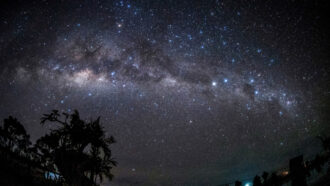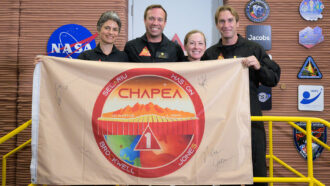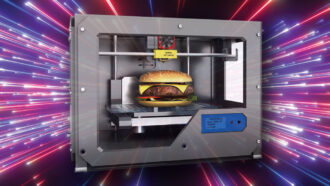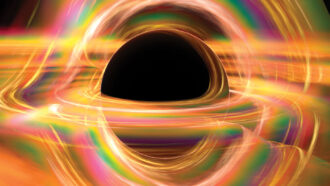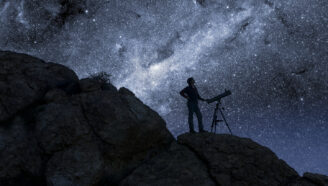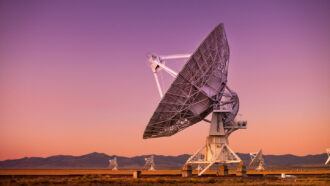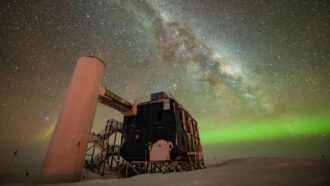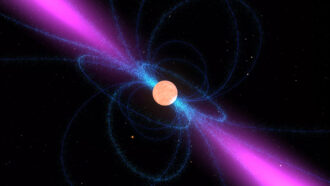New telescope images may unveil stars fueled by dark matter
If they exist, “dark stars” could tell us about dark matter and the early universe
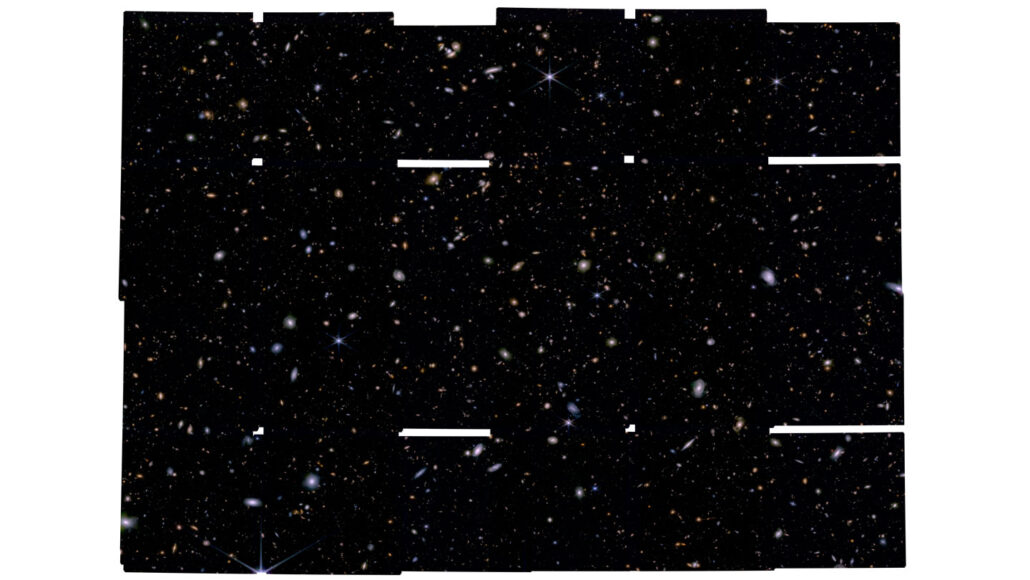
The James Webb Space Telescope captured this collection of images showing some of the oldest galaxies in the universe. The white bands mark where no images have been taken (so data don’t exist).
NASA, ESA, CSA, JADES Collaboration
By Skyler Ware
The James Webb Space Telescope may have spotted a new type of star.
Some of the telescope’s recent pictures have turned up three potential “dark stars” — ones powered by dark matter. That’s the invisible stuff that makes up most matter in the universe.
Researchers shared their finding July 25 in the Proceedings of the National Academy of Sciences.
Scientists aren’t sure the objects in these James Webb images really are dark stars. In fact, they aren’t entirely sure dark stars even exist.
But if any of these objects do turn out to be dark stars, they could tell us a lot about the early universe. They could point to how the first stars formed and give us clues about the nature of dark matter. They might even help explain the origins of the universe’s biggest black holes.
What are dark stars?
Scientists first proposed the existence of dark stars in 2007. The idea came from a team led by Katherine Freese. A cosmologist, she studies the universe at the University of Texas at Austin.
If dark stars exist, they “would be very weird-looking,” Freese says. The sun and other normal stars make light and heat by smashing hydrogen atoms together under immense pressure. When these hydrogen atoms fuse together — forming helium — they give off lots of energy. This process, called fusion, powers all the stars we see today.
In contrast, dark matter would power dark stars. Scientists aren’t sure precisely what dark matter is or how it works. We know only that it exists — because dark matter’s gravity tugs on stuff we can see, such as galaxies. But it’s possible that dark matter also can interact with itself. When two dark matter particles collide, they could destroy each other. Like fusion, that annihilation could produce enough light and heat to power a star.
Dark stars can’t form today; there’s just not enough dark matter around. But these celestial bodies might have formed in the infant universe. That might be a few hundred million years or so after the Big Bang. (That’s when the universe exploded into existence, more than 13 billion years ago.)
Dark stars would have formed from clouds of hydrogen and helium. Gravity would have drawn these two elements together, along with any dark matter nearby. As the dark matter particles got closer, they would start annihilating each other, producing heat. That heat would keep the cloud of hydrogen and helium from collapsing completely to form a normal star. This would work similarly to the way heating the air inside a hot air balloon keeps the balloon inflated.
Since dark stars wouldn’t compress into tight balls of gas as normal stars do, they could grow to huge sizes. They might be up to 10 times as wide as the Earth’s orbit around the sun. That’s over 2,000 times the width of the sun itself!
The biggest dark stars could be millions of times as massive as the sun. They also could be billions of times as bright — as bright as an entire galaxy. That might even be bright enough to be spotted by the James Webb Space Telescope, or JWST. This giant telescope orbiting Earth looks for very ancient, distant objects.
Dark stars found?
Freese and her colleagues wanted to see if any dark stars might be lurking in JWST images. Such a telescope can look back in time. And so far, JWST has taken pictures of more than 700 objects from the first few hundred million years after the Big Bang.
Freese and her team looked at four of the oldest. The researchers could tell these objects were so old because the light they’ve given off has gotten really stretched out by the expansion of the universe — which has been expanding since the Big Bang.
Many scientists think the objects inspected by Freese’s team are small galaxies. But because these objects are so far away, they look like tiny pinpricks of light in JWST’s pictures. So no one can be sure those objects really are galaxies, Freese and her colleagues say. The mystery objects also might be large, super-bright stars full of dark matter.
The team used computer models to predict how much light a dark star might produce at various wavelengths. Then, they compared those predictions to images of the four objects captured by JWST. The images had reflected the cosmos in terms of different wavelengths of incoming light.
Three of the four objects seen by JWST matched what the models of dark stars had predicted. That means those three real-world objects look how scientists would expect dark stars to look.
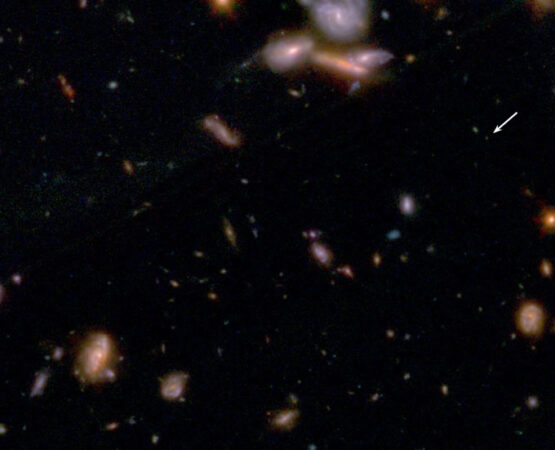
That doesn’t confirm these are dark stars, though. The pinpricks of light in the JWST images also could come from more familiar types of stars, says Sandro Tacchella. He’s an astrophysicist at the University of Cambridge in England.
More work is needed to confirm if any of the objects is a dark star, adds Brant Robertson. He’s an astrophysicist at the University of California, Santa Cruz. Scientists would need to match the computer models of dark stars to more detailed data from JWST, he says. That might help convince him and others that dark stars truly exist.

Educators and Parents, Sign Up for The Cheat Sheet
Weekly updates to help you use Science News Explores in the learning environment
Thank you for signing up!
There was a problem signing you up.
If dark stars exist
Finding dark stars “would be revolutionary,” says Cosmin Ilie. He’s an astrophysicist at Colgate University in Hamilton, N.Y., and an author of the new study.
Detecting dark stars would provide a new type of evidence that dark matter exists. It could also hint at how this mysterious substance works. Knowing that dark matter could annihilate itself “would be really, really powerful,” says Tracy Slatyer. A physicist at MIT in Cambridge, Mass., they did not take part in the new study. Such knowledge could help scientists look for dark matter elsewhere in the universe, Slatyer adds.
Dark stars also might help explain the origins of supermassive black holes. These cosmic monsters, with millions or billions of times the mass of our sun, sit at the center of many galaxies. Smaller black holes can form when giant stars die and collapse. Scientists aren’t sure how supermassive ones form — much less get so big. Dark stars could provide one answer.
Once all the dark matter inside a dark star has annihilated itself, the remaining cloud of hydrogen and helium would collapse. That cloud would still be millions of times as massive as the sun, so its collapse would create a huge black hole. Those giants might later merge over time into supermassive black holes.
Future experiments could help determine whether the three objects studied by Freese’s team are dark stars. For instance, looking for brighter or dimmer light at certain wavelengths could reveal whether the distant objects are dark stars or galaxies. Freese also expects to find other possible dark stars in newer JWST data. But for now, whether dark stars truly exist remains a mystery.
